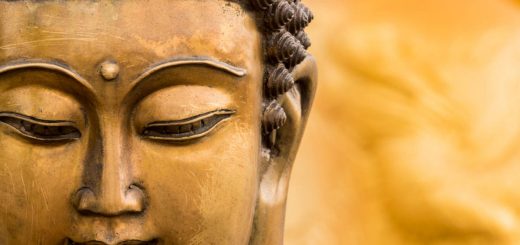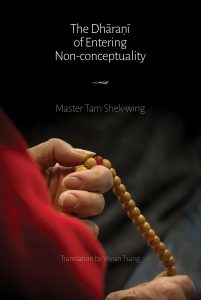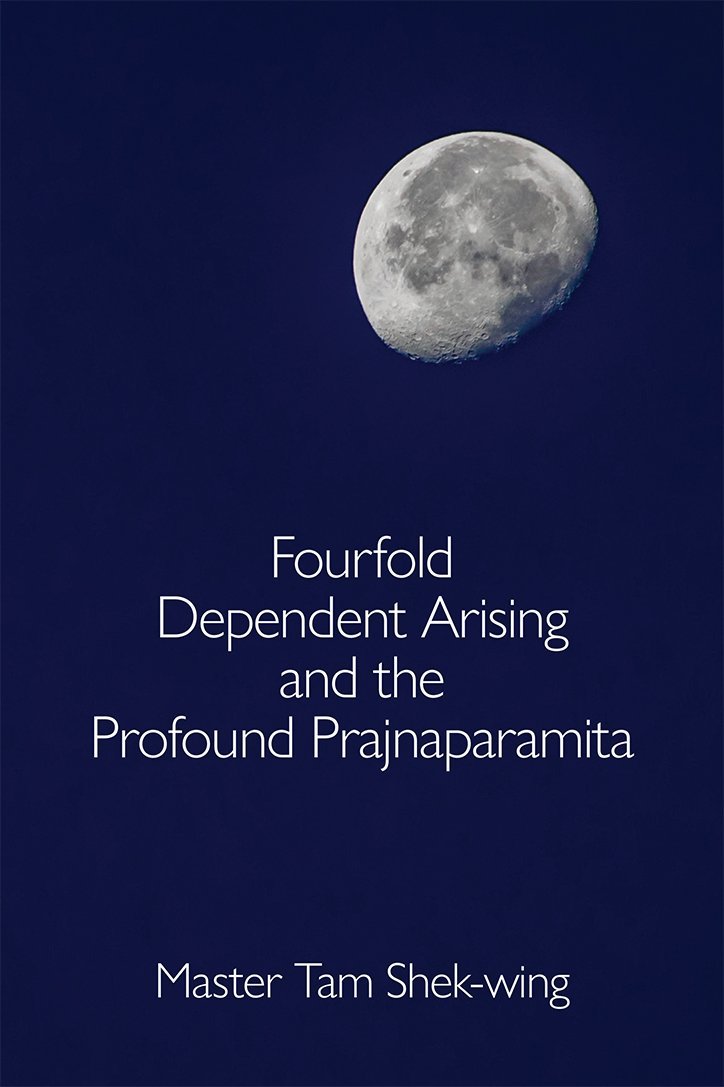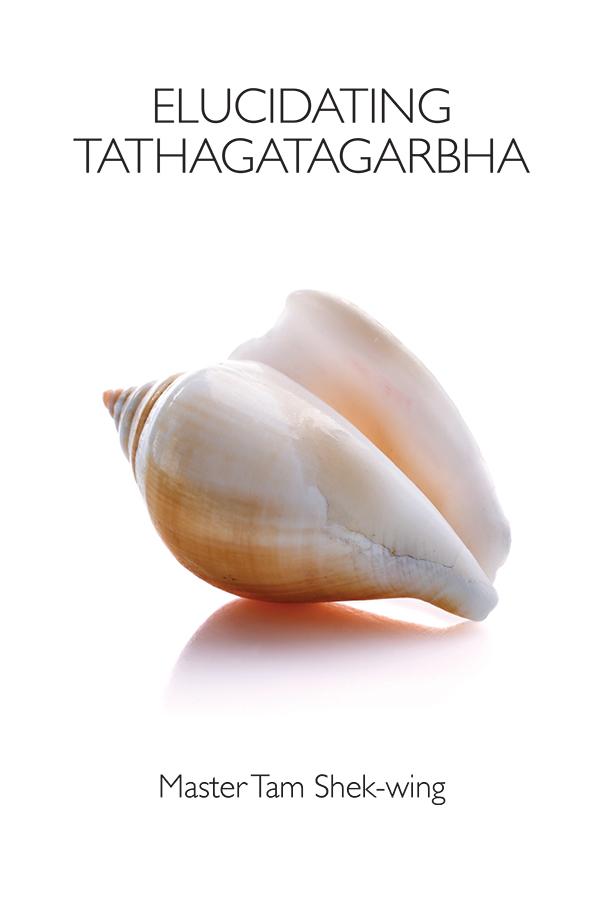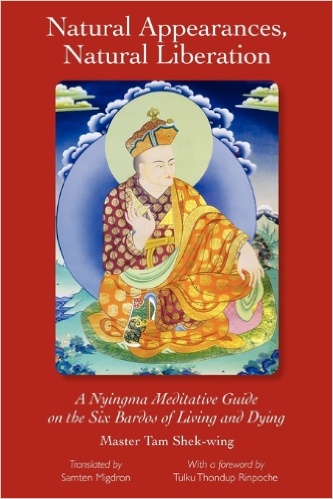Perfect Enlightenment 11: Buddha Answers: On the Stages of Practice
Show scripture (Chinese). 爾時,世尊告普眼菩薩言:「善哉!善哉!善男子!汝等乃能為諸菩薩及末世眾生,問於如來修行漸次、思惟、住持乃至假說種種方便,汝今諦聽!當為汝說。」時,普眼菩薩奉教歡喜,及諸大眾默然而聽。 「善男子!彼新學菩薩及末世眾生,欲求如來淨圓覺心,應當正念遠離諸幻,先依如來奢摩他行,堅持禁戒,安處徒眾,宴坐靜室,恒作是念:『我今此身四大和合,所謂髮毛、爪齒、皮肉、筋骨、髓腦、垢色皆歸於地,唾涕、膿血、津液、涎沫、痰淚、精氣、大小便利皆歸於水,暖氣歸火,動轉歸風。四大各離,今者妄身當在何處?』即知此身畢竟無體,和合為相,實同幻化。四緣假合,妄有六根;六根、四大中外合成,妄有緣氣,於中積聚,似有緣相假名為心。善男子!此虛妄心若無六塵則不能有,四大分解無塵可得,於中緣塵各歸散滅,畢竟無有緣心可見。 「善男子!彼之眾生幻身滅故幻心亦滅,幻心滅故幻塵亦滅,幻塵滅故幻滅亦滅,幻滅滅故非幻不滅;譬如磨鏡垢盡明現。 「善男子!當知身心皆為幻垢,垢相永滅十方清淨。善男子!譬如清淨摩尼寶珠,映於五色隨方各現,諸愚癡者見彼摩尼實有五色。善男子!圓覺淨性現於身心隨類各應,彼愚癡者說淨圓覺實有如是,身心自相亦復如是;由此不能遠於幻化。是故我說身心幻垢,對離幻垢說名菩薩;垢盡對除,即無對垢及說名者。 Show scripture (English). Then the World Honoured One, addressing the bodhisattva Universal Vision, said: “Excellent, excellent! Good son, you have asked well for the bodhisattvas and sentient beings of the degenerate age about the stages of the Tathāgata’s practice; about his thought and abiding, and about the explanation of all the various expedient means. Now listen well, and I shall explain for you.” Universal Vision Bodhisattva received this instruction with great joy. The great assembly became silent and listened. “Good sons, these newly awakened bodhisattvas and sentient beings of the degenerate age who yearn for the pure enlightened mind of the Tathāgata must correct their thoughts and rid themselves of all illusions, first relying on the Tathāgata’s practice of śamatha. Firmly established in moral discipline and living in harmony with like-minded students, then practicing silent sitting in a quiet room, they should uninterruptedly be mindful of the following: “This present body is a synthesis of the Four Elements. Hair, nails, teeth, skin, flesh, bones, marrow, brains and pigment all return to Earth. Saliva, mucus, pus, blood, sputum, scum, phlegm, tears, semen, urine and feces all return to Water. Heat returns to Fire, and movement returns to Wind. When the Four Elements have been separated, where can the false body exist? Now you know that this body ultimately has no substance. As a synthesis it appears, but in reality it is like an illusion conjured by a magician.” “When these four factors temporarily combine, the Six Faculties falsely appear; through the internal and external matching of the Six Faculties and Four Elements, there is the deluded apprehension of conditioned energy. Within this conglomeration, there seem to be marks of this conditioned energy, which is provisionally called mind. Good sons, if this false mind does not have its Six Objects, it cannot exist. If the Four Elements are separated, there are no objects to be experienced. At this point, the cognized objects each disperse and vanish, and ultimately there is no dependently arisen mind to be seen.” “Good sons, since the illusory body of this sentient being vanishes, the illusory mind also vanishes. Since the illusory mind vanishes, illusory objects also vanish. Since illusory objects vanish, illusory vanishing also vanishes. Since illusory vanishing vanishes, non-illusion does not vanish. It is like polishing a mirror: when the filth is gone its brightness naturally appears. Good sons, you should understand both body and mind to be illusory filth. When the defiled aspects are permanently extinguished, the entire universe becomes pure.” “Good sons, it is like a pure mani-jewel which reflects as all kinds of colors, depending upon its surroundings. The foolish see that pearl as really having these colors. Good sons, the pure nature of Perfect Enlightenment is disclosed in bodies and minds, according to each individual type. When these ignorant fellows say that pure Perfect Enlightenment really has body and mind, it is the same sort of error. It is only because these people are unable to free themselves from illusory appearances that I call body and mind ‘illusory filth.’ The one who opposes and removes illusory filth is named ‘bodhisattva.’ When filth is gone, its opposition is removed; then there is no opposition, no filth, nor anything to be named.” Buddha answers Universal Vision’s inquiry on the stages of practice, they are the various “provisional expedient means” such as contemplation and abiding. By expedient, the stages are presented on the basis that they are in themselves insubstantial, and the practices are presented on the basis that they are a non-requirement. Take the Pure Land tradition as an example. There was a dhāraṇī practice with sound as an entrance to the land of eternal quiescent luminescence, but in turn other practices are established expediently, such as reciting Buddha’s name (like a mantra), visualizing Buddha and observing the true appearances during the recitation. All doctrines, then, such as consciousness-only, dharmalakṣaṇa, Madhyamaka, dependent origination, are only expedient means. Even prajñā pāramitā is an expedient mean; the Buddha-Within is an expedient mean, it is at most an expedient mean leading to the ultimate. Abiding by the correct thought, one can cut off the contaminated thoughts to arrive at non-thought. The appearance of mind as non-thought is the appearance of the primordially pure perfectly enlightened mind, and therefore, there is not truly a gradual practice. That said, according to the expedient means, Buddha further said, “[F]irst relying on the Tathāgata’s practice of śamatha. Firmly established in moral discipline and living in harmony with like-minded students, then practicing silent sitting in a quiet room…” Śamatha means cessation, where it is part of the cessation-observation practice. When mind abides in a realm without conceptualization is the practice of cessation. A practitioner upholds the moral discipline and living in harmony in one’s practice, one follows the stages of practice to the two selflessnesses (selfless of the ego self, selfless of the phenomenal self), which is also called the two emptiness observations (emptiness of the ego self, emptiness of the phenomenal self). On selflessness of ego self and phenomenal self... click to show more. In the practice of the selflessness of the ego self, one begins with the selflessness of body, which is a practice of body-abiding according to the thirty-seven aspects. By visualizing one’s body as an amalgamation of the Four Elements, provisionally labelled as the self, then beyond the Four Elements there is no body to attain, nor is the self attainable. Body and self are what the scripture refers to a false cognition of the Four Elements as the appearance of body-self. The subsequent practice is the selflessness of mind. What is mind? The scripture says, “When these four factors temporarily combine, the Six Faculties falsely appear; through the internal and external matching of the Six Faculties and Four Elements, there is the deluded apprehension of conditioned energy. Within this conglomeration, there seem to be marks of this conditioned energy, which is provisionally called mind.” This is to say that the Four Elements as the condition become the Six Faculties. The amalgam of the Six Faculties and the Four Elements (“the internal and external matching”) becomes the apprehensible energy. (Buddhists speak of the non-duality of mind and energy, if the mind is apprehensible, so is the energy.) At this point, the Six Faculties appear to have the apprehensible characteristics, the six consciousnesses becomes functional, capable of making conceptual distinctions, capable of being attached to the Six Objects. The accumulation of this apprehensible energy is provisionally called mind, or what the scripture deems as the false cognition of Six Objects as the appearance of mind-self. From the above practices of observing selflessness of body and selflessness of mind, it should become clear that there is not a self that is attainable. This concludes the practice of selflessness of the ego self. What follows is the practice of selflessness of phenomenal self. The selflessness of phenomenal self builds upon the selflessness of ego self. Beginning with the wisdom observation of the external body and the inner mind, since they are both illusory manifestations, when the illusory body vanishes, the illusory mind vanishes, the illusory objects also vanish. Since the illusory objects vanish, the vanishing of illusions also vanishes. On the vanishing of illusion... click to show more. Subsequently, Buddha explained the principle behind the vanishing of illusion. The scripture says, “Since illusory vanishing vanishes, non-illusion does not vanish. It is like polishing a mirror: when the filth is gone its brightness naturally appears.” This is to say, even if the vanishing of illusion is insubstantial, one cannot say that the illusion does not vanish. Considering the mirror polishing analogy, by polishing, the dirt on the mirror is gone. When the dirt is gone, the mirror naturally appears. The illusory vanishing is like polishing a mirror, the mirror polishing is itself also illusory, an illusory act, all conventional matters are illusory acts. And yet, despite the vanishing of such illusory acts, they have the capacity of vanishing illusion. Therefore, polishing the mirror has the function of revealing the mirror. With this principle in mind, the next section explains what dharmadhātu is. Click here for an introduction on the Sutra of Perfect Enlightenment.Chinese:
English:
Commentary:
 Buddha taught the gradual practices began with correct thought. Correct thought means non-thought: when conceptual thoughts no longer arise is considered non-thought. Buddha called this realm primordially pure — thoughts that are conceptual are also contaminated, imagined, pervasive calculating, dualistic grasping, conceptuality, upon which all perception of illusion manifest themselves, all rooted in ignorance. To detach from the illusion begins with this correct view. And following the correct view, becoming free from contaminations, the imagined, and so on is then the correct thought.
Buddha taught the gradual practices began with correct thought. Correct thought means non-thought: when conceptual thoughts no longer arise is considered non-thought. Buddha called this realm primordially pure — thoughts that are conceptual are also contaminated, imagined, pervasive calculating, dualistic grasping, conceptuality, upon which all perception of illusion manifest themselves, all rooted in ignorance. To detach from the illusion begins with this correct view. And following the correct view, becoming free from contaminations, the imagined, and so on is then the correct thought. The vanishing of illusion also vanishes, it is the wisdom where the vanishing of illusion is insubstantial. Say one holds the view of emptiness to observe this vanishing of illusion, this view of emptiness must also vanish; if one holds the view of dependent origination to observe this vanishing of illusion, this view of dependent origination must also vanish. This way, no doctrinal meanings are truly attainable. This explains why Prāsaṅgika of Madhyamaka tradition does not establish any doctrinal views for themselves, for whatever views encountered can be defeated, and is therefore definitive. The Great Madhyamaka tradition also does not establish any doctrinal views, nor do they uphold the two truths. While they do not aim to defeat any views, they only transcend the views, and are therefore, ultimate.
The vanishing of illusion also vanishes, it is the wisdom where the vanishing of illusion is insubstantial. Say one holds the view of emptiness to observe this vanishing of illusion, this view of emptiness must also vanish; if one holds the view of dependent origination to observe this vanishing of illusion, this view of dependent origination must also vanish. This way, no doctrinal meanings are truly attainable. This explains why Prāsaṅgika of Madhyamaka tradition does not establish any doctrinal views for themselves, for whatever views encountered can be defeated, and is therefore definitive. The Great Madhyamaka tradition also does not establish any doctrinal views, nor do they uphold the two truths. While they do not aim to defeat any views, they only transcend the views, and are therefore, ultimate.
